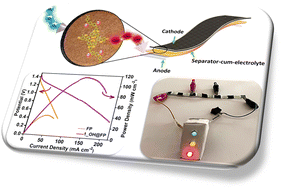Hydroxide ion-conducting viologen–bakelite organic frameworks for flexible solid-state zinc–air battery applications†
Abstract
Adaptable polymer-based solid-state electrolytes can be a game-changer toward safe, lightweight flexible batteries. We present a robust Bakelite-type organic polymer covalently decked with viologen, triazine, and phenolic moieties. Its flexible structure with cationic viologen centers incorporates counter-balancing free hydroxide ions into the polymeric framework. By design, the aromatic groups and heteroatoms in the framework can be activated under an applied potential to prompt a push–pull drive, setting off the towing of hydroxide ions via weak electrostatic, van der Waals, and hydrogen-bond interactions. The frontier orbitals from a DFT-modeled structure certify this. The hydroxyl-polymer requires minimal KOH wetting to maintain a humid environment for Grotthuss-type transport. The hydroxide ion conductivity reaches a value of 1.4 × 10−2 S cm−1 at 80 °C and 95% RH, which is retained for over 15 h. We enhanced its practical utility by coating it as a thin solid-state separator-cum-electrolyte on readily available filter paper. The composite exhibits a conductivity of 4.5 × 10−3 S cm−1 at 80 °C and 95% RH. A zinc–air battery (ZAB) constructed using this polymer-coated paper as electrolyte yields a maximum power density of 115 mW cm−2 and high specific capacitance of 435 mA h g−1. The power density recorded for our ZAB is among the best reported for polymer electrolyte–based batteries. Subsequently, the flexible battery fabricated with IISERP-POF11_OH@FilterPaper exhibits an OCV of 1.44 V, and three batteries in series power a demo traffic signal. To underscore the efficiency of hydroxide ion transport through the complex multifunctional backbone of the polymer, we calculated the diffusion coefficient for OH− (Exp: 2.9 × 10−5 cm2 s−1; Comp. 5.2 × 10−6 cm2 s−1) using electrochemical methods and MD simulations. Climbing-edge NEB calculations reveal a large energy barrier of 2.11 eV for Zn2+ to penetrate the polymer and identify hydroxide ions within the polymer, suggesting no undesirable Zn2+ crossover. Our findings assert the readily accessible C–C-linked cationic polymer's capacity as a solid-state electrolyte for ZABs and any anion-conducting membrane.

- This article is part of the themed collections: Horizons Community Board collection: new trends in energy storage and harvesting and Nanoscale Horizons and Nanoscale: Nanomaterials for Energy


 Please wait while we load your content...
Please wait while we load your content...